A thin rain of charged particles continually bombards our atmosphere from outer space. The mysterious particles were first detected 100 years ago but until 10 years ago when a new type of telescope began to come online physicists weren’t sure where the “cosmic rays” came from or how they were generated. They suspected the particles were accelerated by supernova shockwaves, but suspicions aren’t proof.
Imaging atmospheric Cherenkov telescopes now keeping a watchful eye on the night skies are finally providing the evidence needed to solve this longstanding puzzle. Over the past several years, observations of individual supernovae remnants in our galaxy have gradually strengthened the case for supernova acceleration.
But this fall the evidence suddenly got much stronger. The VERITAS consortium reported their observations of a starburst galaxy. This time the physicists were observing many supernovae at once instead of one by one. As they reported in Nature the correlation between the high cosmic-ray density in the core of this galaxy and its high supernova rate provides powerful evidence in support of the theory of supernova acceleration.
Six of the papers co-authors are physicists at Washington University in St. Louis, one of the founding groups in the VERITAS consortium, a collaboration of 22 institutions that runs a four-telescope array in the Santa Rita foothills south of Tuscon. The last of the three major imaging atmospheric Cherenkov arrays to come online (the other two are MAGIC in the Canary Islands, H.E.S.S. in Namibia), VERITAS saw “first light” in September 2007, just two years ago.
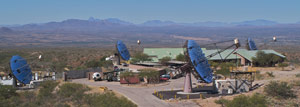
Cosmic rays discovered
It all began nearly 100 years ago with a tenacious response to what most people would have considered a passing irritation. The Viennese physicist Victor Hess wanted to know why an instrument used to measure radiation, called a gold-leaf electroscope, would slowly discharge even when there was no obvious source of radiation nearby. What was ionizing the air within the instrument case and letting the charge leak away?
To figure out where the radiation was coming from, Hess made balloon ascents in 1911 and 1912, carrying electroscopes with him. He expected the instruments would discharge more slowly at higher altitudes. Instead, he found that they discharged more rapidly.
Hess decided the radiation was coming from outer space and named it cosmic radiation. He won the Nobel Prize in physics in 1936 for his discovery.
Why it took so long
The famous American physicist Robert Millikan called Hess’s penetrating radiation “cosmic rays,” but “rays” is a misnomer. The “rays” are not light but instead are atomic nuclei, mostly hydrogen nuclei, or protons, with a sprinkling of helium and heavier nuclei.
Unlike light, these particles carry electric charge. And that’s a problem because space is laced by magnetic fields, and charged particles spiral around magnetic field lines. These deflections and detours so tangle the particles’ paths that by the time they arrive at Earth they appear to be arriving in equal numbers from all directions.
Because the rays themselves don’t point back to their sources, astronomers have to track them down by other means. When cosmic rays collide with other atomic nuclei in gas or dust, they produce gamma rays, which are a kind of high-energy light. The gamma-ray portion of the electromagnetic spectrum covers a lot of territory, but some of the most energetic gamma rays have trillions of times the energy of the light we can see.
Because gamma rays travel in straight lines physicists can trace them backward – with luck to objects that can be observed with conventional telescopes at other wavelengths.
But there is another obstacle to overcome. Gamma rays make it nearly to Earth but not quite. They can’t penetrate the atmosphere, and so, like cosmic rays, they must also be detected indirectly.
When a very energetic gamma ray interacts with an atom in the upper atmosphere, the collision can create a pair of particles: an electron and its antiparticle, the positron. This debris can interact with another atom yielding more electrons, positrons and photons, creating an avalanche of billions of particles called “an extensive air shower.”
Because the particles are traveling faster than the speed of light in the atmosphere, they create a shock wave similar to the sonic boom from a supersonic jet. The shock wave takes the form of a cone of bluish light known as Chernekov radiation. (The blue glow of the cooling water in a nuclear reactor is created by the same process.)
The flashes of light from an extensive air shower are so faint and brief they can’t be seen with the unaided eye. To record them, Chernekov telescopes like VERITAS use extremely sensitive and fast “cameras” made of hundreds of photomultiplier tubes.
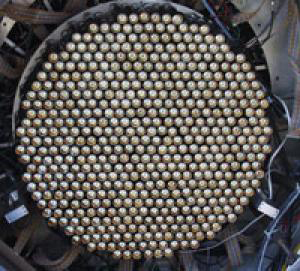
The Washington University group founded by James H. Buckley, Ph.D., professor of physics in Arts & Sciences and a member of the McDonnell Center for the Space Sciences at the University, designed and built the high-speed electronics capable of making “movies” of the flashes at a blistering half a billion frames per second. The frame rate of a standard movie camera, by contrast, is 24 frames per second.
The four telescopes in the VERITAS array each provide a different view of an air shower, providing a better fix on the direction of the incoming gamma ray.
Accelerators in space
Scientists knew from the start that cosmic radiation had to come from unusual astrophysical sources. Cosmic rays are what is called non-thermal radiation. That is, you can’t get this kind of radiation just by heating something up, even to the nuclear furnace temperatures of stellar interiors.
Instead, to make cosmic rays, you need something more like a particle accelerator. But the world’s highest-energy accelerator is designed to boost protons to an energy of only a few tera-electron-Volts, and by the standards of cosmic rays, that’s nothing. Some of them have energies 100 million times higher.
An accelerator works by using electromagnetic fields to continually kick particles confined to a ring to higher and higher energies. To get up to cosmic ray energies, however, the particles would have to be subject to very strong electromagnetic fields over enormous distances. So, at a minimum, cosmic accelerators must be huge and exceedingly violent objects.
And that’s more or less what VERITAS and the other telescopes are finding them to be.
A supernova remnant
Even before all four telescopes were up and running, the VERITAS array was used to observe IC 443, also known as the Jellyfish nebula, a galactic supernova remnant in the constellation Gemini.
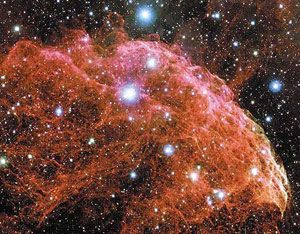
IC 443 is thought to be the remains of a star that blew itself apart thousands of years ago. The massive explosion left behind the collapsed remnant of the star’s core, in the form of a spinning neutron star, and a rapidly expanding shell of gas.
When material speeding out from the supernova hit the interstellar medium, it created a shock wave. In the southeast corner of the nebula the shock wave is slamming into a dense molecular cloud, perhaps the cloud from which the star originally condensed.
VERITAS found that high energy gamma-ray emission was confined to a region in the remnant where the molecular cloud was thickest.
It seemed the shock wave was acting as a gigantic accelerator, and gamma rays were being unleashed when protons energized by the shock front struck the nearby molecular cloud.
This interpretation of the results made sense, but was it true?
The physicists weren’t entirely sure.
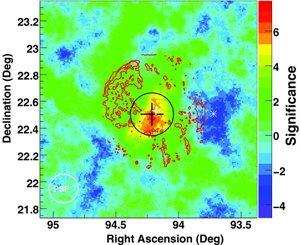
For one thing, energetic electrons as well as atomic nuclei can produce gamma rays. Electrons accelerated to high energies by the supernova might be colliding with low-energy photons, boosting them to gamma-ray energies. This is called the inverse Compton effect.
Arthur Compton described the opposite process — in which high energy photons collide with stationary particles — while at Washington University, work for which he won the Nobel Prize in physics in 1927. The theory of the inverse effect was first set out by two of Compton’s colleagues at the University, Eugene Feenberg and Henry Primakoff, in 1948.
But Buckley and his colleagues were also aware that one observation was not much to go on. It was possible that supernova remnant IC 443 wasn’t typical but rather somehow anomalous or unusual.
Since 2007, VERITAS has taken gamma-ray snapshots of other supernova remnants, including Boomerang and gamma Cygni, observed just this summer. They show much the same gamma-ray emission as IC 443.
Many supernovae at once
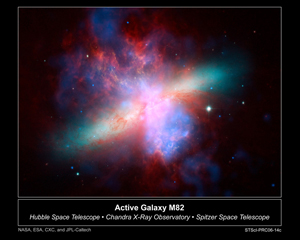
The latest find, announced Nov. 1 in the online journal Nature, is qualitatively different. This time the telescopes were looking at the diffuse gamma-ray emission from an entire galaxy, one that has many supernova remnants.
They were looking at an entire forest instead of a single tree.
The galaxy is M82, a starburst galaxy five times brighter than the entire Milky Way. There are many starburst galaxies, says Henric Krawczynski, Ph.D., associate professor of physics and a member of the McDonnell Center for the Space Sciences, who together with Buckley, has led many of the VERITAS scientific programs, “but we chose to observe M82 because it is close to our Milky Way galaxy and combines a high rate of star formation with a high density of interstellar matter. “
M82 is also called the cigar galaxy because it was deformed into a long, fat slug by a collision with a nearby galaxy. The encounter funneled gas into the galaxy’s core, creating a compact region where stars are being formed about 10 times faster than in the Milky Way and supernova pop off with alarming frequency
The ferment of stellar explosions, the astronomers reasoned, should be churning out cosmic rays and gamma rays.
Not that the gamma rays would be easy to see, because the supernovae in the starburst galaxy are much farther away than IC 443 or other supernovae in our galaxy. Although VERITAS is presently the most sensitive gamma-ray observatory in the world, it took almost two years of repeated observations to detect the predicted signal.
But the data, once gathered, indicated that the starburst region of M82 has a cosmic ray density 500 times the average cosmic ray density of our galaxy. Its estimated supernova rate is about 30 times higher than the Milky Way’s. The correlation between the cosmic-ray density and the supernova rate strongly supports the long-held theory that supernovae are cosmic ray factories.
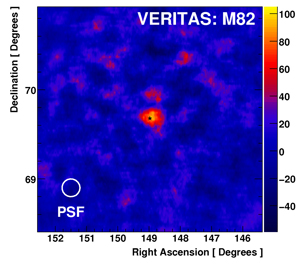
What they know and when they knew it
So do physicists feel they now know where and how cosmic rays are generated?
Buckley’s response is carefully worded. “After all of these years, we’re starting to see evidence both from discrete sources– the supernova remnants– and at the galactic scale–the starburst galaxy–that supernova explosions are really the source of cosmic rays.”
“If we finally see neutrinos coming from the sources,” he says, “then we’ll know absolutely that protons, not electrons, are producing the gamma rays, because only the protons will give you neutrinos.”
“But even if we knew where they’re coming from, we wouldn’t know the exact mechanism by which they’re accelerated,” he continues. “Shock acceleration is very nice, but there are problems with it and ultimately the devil is in the details.”